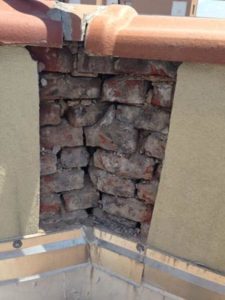
Investigative probes can uncover hidden defects, like this crumbling parapet wall concealed by stucco.
When it comes to your health, ignorance is not bliss. Refusing to let your doctor perform routine tests and procedures because you’re afraid he’ll find you have a disease is a shortsighted, if not willfully blind, decision. So is avoiding the doctor altogether because you don’t feel sick and think a check-up is unnecessary. Both approaches disregard potential problems and could lead to medical complications down the road. The smart patient allows his physician to perform a proper examination, look for symptoms, determine if there’s anything that needs further monitoring, and if called for, provide the necessary treatment.
The same principle applies to the health of your building. Some property owners and managers would prefer not to know if their building has any major issues because of the expensive repair costs entailed, or they just assume everything is OK because there are no obvious problems. But it’s what you don’t know that can hurt you.
For most exterior repair projects, the engineer or architect requests investigative probes as a routine part of the initial site evaluation. Probes entail carefully cutting (and subsequently sealing) an opening in a building element, such as a roof membrane or a wall, to get a better look at what's below or behind the surface. Sometimes what the engineer/architect finds is not always good news, but that’s the whole point of probes—to determine the unknown and address it accordingly.
Although investigative probes add a nominal cost to the project, they can uncover hidden defects in a building, like a water-damaged structural deck or missing waterproofing membrane. With a more complete understanding of the underlying components, the engineer/architect is able to develop a more effective scope of work, minimizing surprises during construction and reducing the number and cost of change orders.
In RAND's latest Ask the Engineer column, we discuss the ins and outs of investigative probes and how they come into play on your building's projects, including:
- Identifying which probes are necessary
- Typical probe locations
- How probes are conducted
- Typical number of probes and costs per project
- Roof probes: Checking for drainage and asbestos
For more on investigative probes, including how a probe of a projected $15,000 work item uncovered $250,000 worth of necessary repairs, read the full article and let us know if you have questions or comments,
When it comes to keeping your building healthy, a little due diligence goes a long way.
